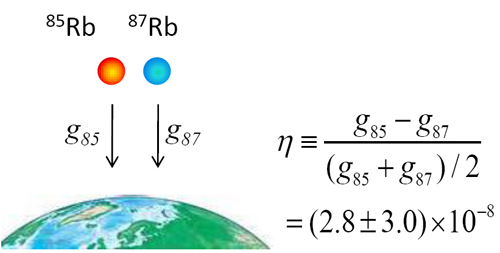| 重要成果 Key Achievements |
- 实现基于光纤阵列的中性原子量子计算新构架
- Demonstration of fiber array architecture for atom quantum computing (2025)
Using a fiber array, we experimentally demonstrate the trapping and independent control of ten single atoms in two-dimensional optical tweezers, achieving individually addressed single-qubit gates with an average fidelity of 0.9966(3). More significantly, we perform simultaneous arbitrary single-qubit gates on four randomly selected qubits, resulting in an average fidelity of 0.9961(4)(Nat. Commun. 16: 9728, 2025).
Experimental scheme. a Basic experimental setup for the trapping, rearrangement, manipulation, and detection of single-atomarrays. b The cross-section of the fiber array. c Single-shot fluorescence image of an atomarraywith 50ms exposure time. d A schematic showing optical setup in the optical module. e Histogram of collected photons for one of the fiber traps during the initial loading process.
- 在国际上首次实现原子干涉陀螺
- Realization of cold atom gyroscope in space (2024)
Our team has developed a space-based dual-component rubidium isotope cold atom interferometer (npj Microgravity 9: 58, 2023). The device was launched aboard the Tianzhou-5 cargo spacecraft on November 12, 2022, and subsequently installed in the high microgravity science experiment cabinet of the Tianhe core module of the China Space Station. On December 30, 2024, the China Manned Space Engineering Office released the《China Space Station Science Research and Application Progress Report (2024)》to the public, selecting 34 representative research achievements and phased progress. Among them was the research on space cold atom interferometry gyroscope technology. This work marks the first demonstration of an in-orbit cold atom gyroscope utilizing an atom interferometer on the China Space Station (Natl. Sci. Rev. 12: nwaf012, 2025).
Physical image of the space cold atom interferometer in orbit
Astronauts conducting suspended cold atom interference experiments inside the Chinese Space Station
- 相干合成单个分子
- Coherently forming a single molecule (2020)
Constructing the simplest molecule from two atoms and achieving coherent conversion between atoms and molecules represents the most fundamental step in matter control. However, limited by decoherence factors, this had not been realized until now. Our team proposed a novel method utilizing the coupling between atomic spin and the relative motional wave function. Ultimately, we achieved the coherent synthesis of individual ultracold 87Rb-85Rb molecules in the ground state of a trapping potential within an optical tweezer, observing long-lived coherent Rabi oscillations between the two-atom pair and the single molecule (Science 370(6514), 331-335, 2020).
Schemes of SMC and molecular association in a tight OT.
- 实现两原子系统
- Realizaed two-atom sysytem (2015)

Schematic diagram of inelastic collisions of heteronuclear diatomic molecules
We successfully achieved controlled cold collisions between a 87Rb atom and a 85Rb atom in a micron-scale optical trap through laser manipulation(Nat. Commun. 6: 7803, 2015).
- 在E-8水平检验弱等效原理
- Test weak equivalence principle at E-8 level (2015)

Schematic diagram of testing the equivalence principle using two-component atoms
We made significant progress in testing the equivalence principle with microscopic particles. They proposed and realized a novel four-wave double Raman (4WDR) diffraction scheme for cold atom interferometry. Utilizing a dual-species atom interferometer, they conducted experiments to test the Weak Equivalence Principle, achieving a precision of 10⁻⁸ (Phys. Rev. Lett. 115, 013004, 2015).


